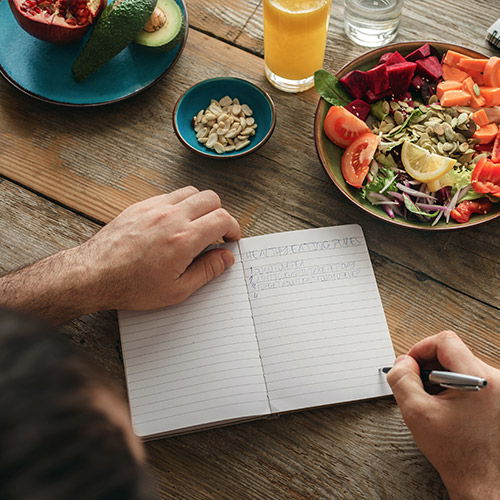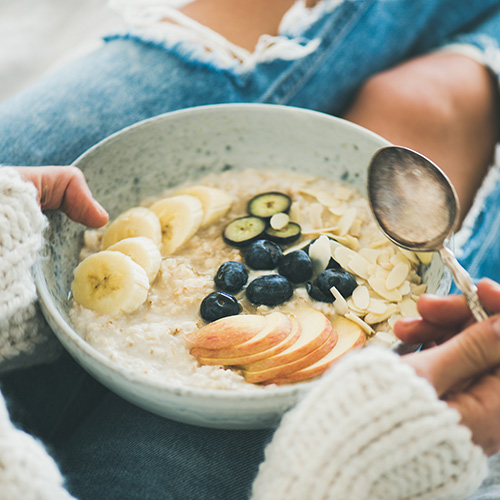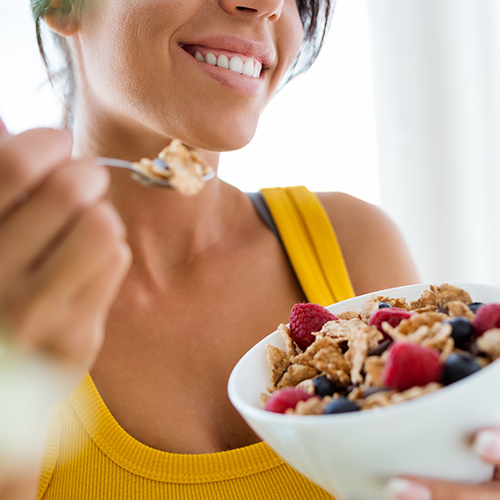
Resolution: Eat More Fruits
Author: be well™ with Big Y® Registered Dietitian Team
Nature’s candy does more than just taste sweet. Fruits are vegetables' BFFs for good reason—they provide similar benefits to your health because their composition are just so darn impressive! Check out our “Eat More Veggies” article to learn more. Yet, just like the colorful counterparts, 9 out of 10 Americans still fall short on meeting daily Fruit Food Group recommendations1.
According to the Produce for Better Health Foundation’s 2020 State of the Plate, though, fruits get slightly less loving than vegetables— with an average intake of 5.8 times per week, versus 7.5 times as observed with veggies.2 Can you believe it?!
Let’s make sure you’re gobbling up your servings of fruit each week in the year ahead so you feel their power. Honestly, what could be more enjoyable than resolving to eat MORE sweet-tasting foods from Mother Nature?
How Many Fruits Are You Eating Each Day?

When it comes to fruit, the thought is the same as vegetables: eat more. Especially since most of us eat so little over the course of a week. That said, to truly identify where you fall with your fruit intake, do a little record keeping for a few days.
Without changing how you eat, keep tabs on how often you’re consuming fruit. On your phone or on paper, simply mark down what you ate over the course of 4-5 days (be sure to include the weekend in there!). Did you drink a glass of orange juice at breakfast? How about a bunch of grapes at lunch? Did dinner come with a fruity dessert like apple pie? Make note.
Don’t change how you eat, but do guestimate the amount you ate. For example, was it a large glass of orange juice or small? Could the bunch of grapes fit into the palm of your hand or were they overflowing? Did you eat a small slice of pie or half a pie? Whatever you ate, make note—and without judgment. You’re on a fact-finding mission here, that’s it. This is not time for shame!
How Many Fruits Should You Be Eating Every Day?

Like vegetable recommendations, the amount of fruit to aim for each day is dependent on the number of calories you need. You can find what level meal plan the Dietary Guidelines recommend for you by visiting MyPlate.gov.
For an average 2,000-calorie meal plan, though, it is recommended to eat 2 cups of fruit every day.
What Counts as a Serving of Fruit?

To reach your daily Fruit Food Group goals, learn what counts as a 1-cup serving:
- 1 small apple or 1/2 large apple
- 1 large banana
- 1 cup whole or cut up grapes/22 seedless grapes
- 1 large orange
- 2-3 kiwifruits
- 1 cup chopped fresh, frozen or canned fruit
- 1 cup fresh or frozen berries
- 8 large strawberries
- 8-ounces 100% fruit juice (orange, apple, etc.)
- 1/2-cup dried fruit (raisins, cranberries, blueberries, chopped dates)
- 8 dried figs
- 10 dates
- 1/3 cup dried mango
- 1 cup applesauce
Adding More Fruits to Your Meals.

As with any food you want to eat more frequently—include more fruits on your plate at every eating occasion throughout the day. Although the listing above shows what counts as a 1-cup serving, there’s no reason you can’t sprinkle fruits into meals in smaller doses throughout the day as you work toward your daily goal. For example, when aiming for 2 cups fruit each day:
- Mash 1/2 large banana to sweeten your breakfast oatmeal in lieu of added sugar {1/2 cup fruit}.
- Add 2 tablespoons raisins to that oatmeal for even more fruit goodness {1/4 cup fruit}.
- Say yes to topping salads with fruit. One large plum sliced thin {1/2 cup fruit} or ~5 halved grapes {1/4 cup fruit} can take a savory salad to the sweet & savory zone.
- Enjoy a bowl of berries topped with whipped cream as dessert during dinner {3/4-1 cup fruit}.
Sweeten Your Snacking.

A helpful way to ensure your snacks get eaten is to choose something your brain is craving. And when blood sugar begins to drop, the brain tends to want sweet-tasting foods for the quickest source of energy (aka- carbohydrates). Fruit is the quintessential answer for your craving and blood sugar. Get the most out of your snack and pair your fruit with a food providing protein and a little bit of fat like:
- 4 large frozen strawberries defrosted on top of plain, non-fat Greek yogurt so their juices sweeten the mix
- 1/2 cup canned peaches in juice on top of low-fat cottage cheese
- 1/2 medium pear with a handful of almonds
- 1/2 large navel orange and beef jerky
- 1 small apple sliced and dipped into nut butter
- 1/4 cup raisins paired with 2 tablespoons shelled pistachios
1 U.S. Department of Health and Human Services and U.S. Department of Agriculture. 2015–2020 Dietary Guidelines for Americans. 8th Edition. December 2015. Available at: http://health.gov/dietaryguidelines/2015/guidelines/.
2 The Produce for Better Health Foundation. State of the plate: America's fruit & vegetable consumption trends 2020 executive summary. Accessed 1/6/2023. https://fruitsandveggies.org/wp-content/uploads/2021/04/2020-PBH-State-Of-The-Plate-Executive-Summary-1.pdf.
Published 1/16/2023


